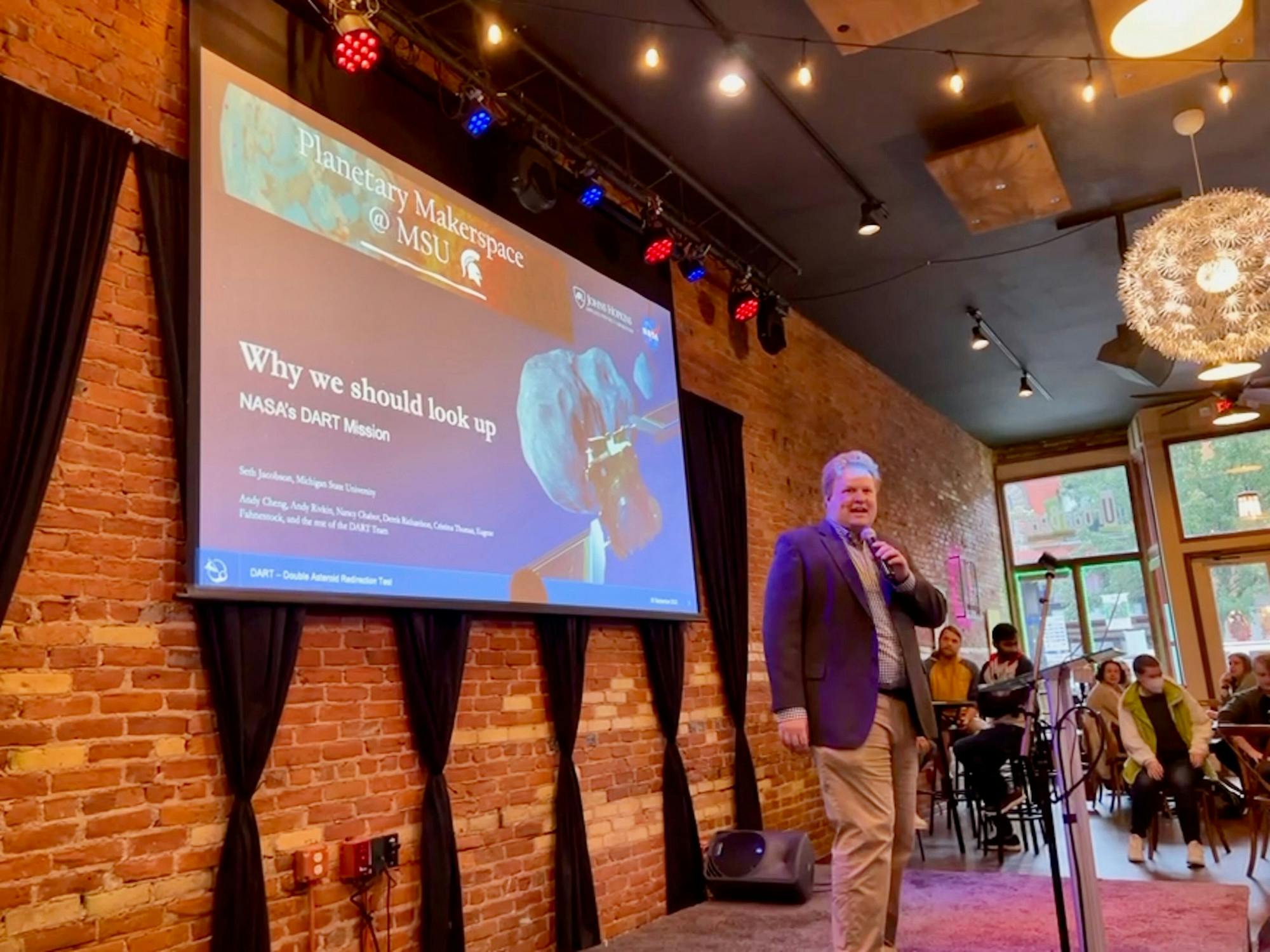NASA’s Double Asteroid Redirection Test, or DART, successfully impacted an asteroid in space this past Monday in the first-ever attempt to deflect an asteroid using kinetic impact.
The DART mission launched into space 10 months ago on a trajectory toward Didymos, an asteroid system that posed no threat to Earth. The system consists of two asteroids: Didymos and a smaller asteroid orbiting Didymos, Dimorphos, which was the final target.
Prior to crashing into the asteroid, which is 530 feet in diameter, DART filmed Dimorphos up-close and the video was live streamed across the world.
Among those watching was Seth Jacobson, who works in DART’s dynamics-working group. He's an assistant professor in the Earth and Environmental Sciences Department at MSU. Jacobson gathered with friends and colleagues at a restaurant to watch as the small white dot in the middle of the black screen grew larger until it was the only object in frame and the cameras crashed into it.
According to Jacobson, although the odds of success grew higher as the spacecraft approached the asteroid, he was still worried something might go wrong. When the collision occurred, Jacobson was relieved and excited he got to see the asteroid he’d been studying for years up close.
“It was fantastic,” Jacobson said. “We've been studying the Didymos-Dimorphos system for a long time from the ground, and when we study from the ground, we never get any sort of detailed information about what the surface looks like, or what the very precise shapes of the objects are. So, watching it come into view, as we approached the asteroid, was really cool. It finally became a very real object, and all these features about its surface and shape were revealed. That was really fun.”
Jacobson first heard about the mission about a decade ago, when he said it was still just “a sketch on chalkboard.” But he became officially involved in the mission about two years ago.
As a member of the dynamics working group, Jacobson's role is to characterize the binary asteroid system the DART mission visited, both before and after impact. This work will help estimate how much momentum was transferred from the spacecraft to Dimorphos.
To do this, the team will analyze data from a variety of sources for the next couple of months. The team has the data from the spacecraft itself regarding the velocity and mass of the spacecraft prior to the impact, as well as the observations of the asteroid and ejecta. The team will also look at data from ground-based observatories and space-based observatories like the Hubble Space Telescope.
With the images from the ground-based telescopes, the team will use a light curve technique to determine Dimorphos’ trajectory. Jacobson said the technique will be particularly effective because Dimorphos passes between Earth and Didymos, and behind Didymos, in every orbit. This means scientists can precisely time when Dimorphos goes in front of and behind Didymos to the millisecond.
According to Jacobson, NASA’s decision to target this system will help the team in multiple ways.
“One of the reasons why we chose a binary asteroid system that has two members… is because we can very precisely measure that small orbit of Dimorphos around Didymos, and we can do that from the ground, which is really nice,” Jacobson said. “It's much harder to measure—to such a level of precision—a single asteroid moving around the sun, for instance. So, the fact that it's a small system means that we can make really precise measurements.”
Once the data is collected, the team will be able to quantify the transfer of momentum, for which they are using a parameter called beta. Beta is calculated by dividing the additional momentum that the target asteroid picks up by how much momentum the spacecraft delivered. Jacobson said he expects the transferred momentum to be greater than the initial momentum from the spacecraft due to the ejecta thrown out from the asteroid.
NASA has images of the DART's mission on its website. Once Jacobson and his team create a precise estimate for beta, NASA will be better equipped for future dangers an asteroid may create.
“If we can get a precise estimate of this value, then we know that when we ever need to conduct this experiment for real, we can then apply the beta, this number that we've now experimentally verified, to our predictions for what we need to do to accomplish the task of potentially saving a city or the planet from a from an impact.”
Support student media!
Please consider donating to The State News and help fund the future of journalism.
Discussion
Share and discuss “MSU professor involved in NASA’s DART mission explains science behind historic event ” on social media.



